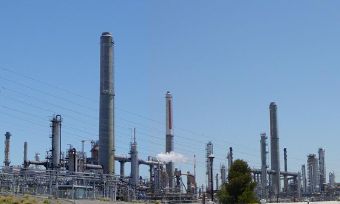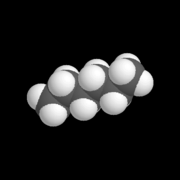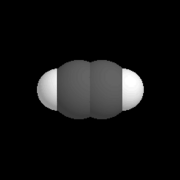Hydrocarbon
In chemistry, a hydrocarbon is any chemical compound that consists only of the elements carbon (C) and hydrogen (H). They all contain a carbon backbone, called a carbon skeleton, and have hydrogen atoms attached to that backbone. (Often the term is used as a shortened form of the term aliphatic hydrocarbon.)
Examples
For example, methane (swamp/marsh gas) is a hydrocarbon with one carbon atom and four hydrogen atoms: CH4. Ethane is a hydrocarbon (more specifically, an alkane) consisting of two carbon atoms held together with a single bond, each with three hydrogen atoms bonded: C2H6. Propane has three C atoms (C3H8) and so on (CnH2n+2).
Three types of hydrocarbons
There are essentially three types of hydrocarbons:
- aromatic hydrocarbons, which have at least one aromatic ring
- saturated hydrocarbons, also known as alkanes, which don't have double, triple or aromatic bonds
- unsaturated hydrocarbons, which have one or more double or triple bonds between carbon atoms, are divided into:
The number of hydrogen atoms
The number of hydrogen atoms in hydrocarbons can be determined, if the number of carbon atoms is known, by using these following equations:
- Alkanes: CnH2n+2
- Alkenes: CnH2n (assuming only one double bond)
- Alkynes: CnH2n-2 (assuming only one triple bond)
Each of these hydrocarbons must follow the 4-hydrogen rule which states that all carbon atoms must have the maximum number of hydrogen atoms that it can hold (the limit is four). Note, an extra bond removes 2 hydrogen atoms and only saturated hydrocarbons can attain the full four. This is because of the unique positions of the carbon's four electrons.
Molecular graph
Usually carbon backbone is represented as molecular graph in which only carbon atoms are represented as vertices and bonds as edges. Molecular graphs contain the structure of the hydrocarbon in which missing hydrogen atoms can be added in a unique way. Hydrocarbons are extensively studied in mathematical chemistry.
Petroleum
Liquid geologically-extracted hydrocarbons are referred to as petroleum (literally "rock oil") or mineral oil, while gaseous geologic hydrocarbons are referred to as natural gas. All are significant sources of fuel and raw materials as a feedstock for the production of organic chemicals and are commonly found in the Earth´s subsurface using the tools of petroleum geology.
Oil reserves in sedimentary rocks are the principal source of hydrocarbons for the energy, transport and chemicals industries. The production of liquid hydrocarbon fuel from a number of sedimentary basins has been integral to modern energy development.
Hydrocarbons are of prime economic importance because they encompass the constituents of the major fossil fuels (coal, petroleum, natural gas, etc.) and biofuels, as well as plastics, waxes, solvents and oils. In urban pollution, these components—along with NOx and sunlight—all contribute to the formation of tropospheric ozone.
Burning Hydrocarbons
Hydrocarbons are currently the main source of the world’s electric energy and heat sources (such as home heating) because of the energy produced when burnt. Hydrocarbons are all substances with low entropy (meaning they hold a lot of energy potential), which can be released and harnessed by burning them. Often this energy is used directly as heat such as in home heaters, which use either oil or natural gas. The hydrocarbon is burnt and the heat is used to heat water, which is then circulated in pipes around the building heating every room. A similar principle is used to create electric energy in power plants. Hydrocarbons (usually coal) are burnt and the energy released in this way is used to turn water in to steam, which is used to turn a turbine that generates energy much like a windmill does. In an ideal reaction the byproducts would be only water and carbon dioxide but because the coal is not pure or cleaned there are often many toxic byproducts such as mercury and arsenic. Also, incomplete combustion causes the production of carbon-monoxide which is toxic because it will bind with hemoglobin more readily than oxygen so if it is breathed in oxygen can not be absorbed, causing suffocation. Clean coal technology is currently under development.
External links
- Dismissal of the Claims of a Biological Connection for Natural Petroleum.
- An introduction to the modern petroleum science, and to the Russian-Ukrainian theory of deep, abiotic petroleum origins.
- Abiogenic Gas Debate 11:2002 (EXPLORER)
See also
- Abiogenic petroleum origin
- Energy storage
- Petroleum geology
- Oil well
ar:هيدروكربون ca:Hidrocarbur da:Kulbrinte de:Kohlenwasserstoffe es:Hidrocarburo eo:Hidrokarbono fa:هیدروکربن fr:Hydrocarbure he:פחמימן id:Hidrokarbon io:Hidrokarbido it:Idrocarburi lv:Ogļūdeņraži ms:Hidrokarbon nl:Koolwaterstof ja:炭化水素 no:Hydrokarbon nn:Hydrokarbon pl:Węglowodór pt:Hidrocarboneto ru:Углеводороды sr:Угљоводоник su:Hidrokarbon fi:Hiilivety sv:Kolväte vi:Hyđrocacbon tr:Hidrokarbon zh:烃
Credits
New World Encyclopedia writers and editors rewrote and completed the Wikipedia article in accordance with New World Encyclopedia standards. This article abides by terms of the Creative Commons CC-by-sa 3.0 License (CC-by-sa), which may be used and disseminated with proper attribution. Credit is due under the terms of this license that can reference both the New World Encyclopedia contributors and the selfless volunteer contributors of the Wikimedia Foundation. To cite this article click here for a list of acceptable citing formats.The history of earlier contributions by wikipedians is accessible to researchers here:
The history of this article since it was imported to New World Encyclopedia:
Note: Some restrictions may apply to use of individual images which are separately licensed.




